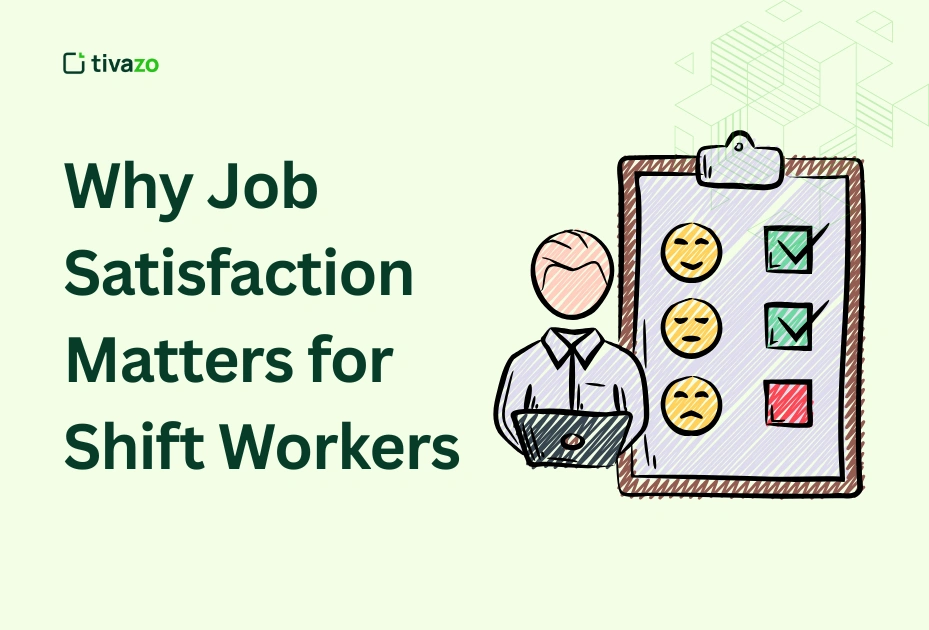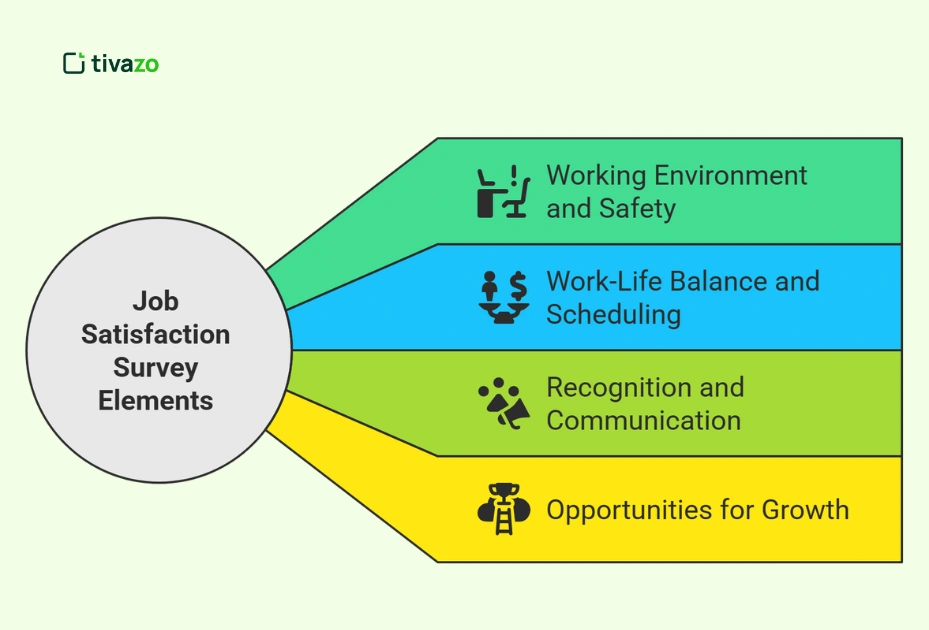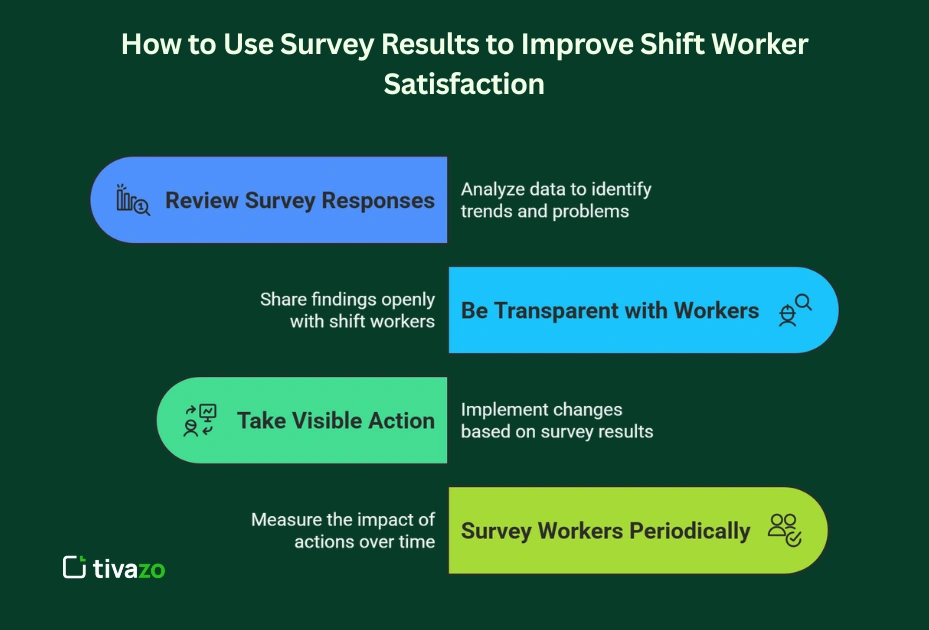Job satisfaction plays a significant role in a workforce’s success, especially for those working shifts. Shift workers face inconsistent hours, varying rotations, altered sleep cycles, stress, fatigue, and a disrupted work-life relationship. If workers are experiencing any of these issues, it can quickly lead to low morale, poor productivity, and ultimately turnover.
To understand the needs and concerns of shift-based employees, organizations rely on specific job satisfaction survey questions. Surveys are helpful for assessing how shift employees are feeling about their work environment, their schedules, their communication, and overall engagement.
In this blog, I will outline the 25 best job satisfaction survey questions tailored for shift workers and how they can help organizations develop better employee morale, retention and workplace satisfaction.
Why Job Satisfaction Matters for Shift Workers

Shift workers endure difficulties that traditional employees may not face such as irregular hours, rotated schedules, and overnight shifts. Inconsistent works schedules can be impactful—from everything like sleep consitions to family time planning. These unpredictabilities can lead to increases in both psychological and emotional stress, physical fatigue, and burnout. Over time, continuous strain on shift workers can lead to decreased morale and performance.
When shift workers feel unsupported or unheard there is an increase in disengagement towards the role of the shift worker. With disengagement, risk for decreased productivity is heightened as is risk of turnover behavior. Turnover behavior can disrupt team operations as well as be costly for the employer to replace people, train them, onboard them and so on.
That is why it is crucial to provide thoughtful, tailored job satisfaction survey questions. Surveying can provide a platform for shift based workers to have a voice where managers can better understand their daily realities in the workplace and pain points. In contrast, job satisfaction survey questions can provide tailored, contextually relevant, and specific information regarding job satisfaction or experiences for shift workers, which allow companies to only act upon these takes more accurately.
If companies are willing to address concerns and truly demonstrate they care about the well-being of their employees, they will foster a better work environment where their shift workers feel valued, engaged, and connected to their work.
Key Elements to Include in a Job Satisfaction Survey for Shift Workers

When soliciting effective feedback from shift workers, you want employee job satisfaction survey questions to concentrate on particular areas that have the greatest impact on shift workers. Typical job satisfaction surveys tend to neglect job or work factors that impact shift workers in their day-to-day experience and working environment, so it is crucial that you consider the focus of your survey question.
- Working environment and safety:
How safe and comfortable do employees feel while they work? For shift workers, the environment that they work in could differ dramatically depending on the time of street and what support they have in the working environment.
- Work-life balance and scheduling:
Are shifts reasonable and manageable, allowing enough recovery time and personal time? Your job satisfaction survey questions should consider whether or not their existing predetermined shifts and scheduling had the potential to facilitate their work-life balance.
- Recognition and communication:
Do workers feel recognized or communicated to? Shift workers miss meetings or updates. So checking their perceptions about clarity of communication and fairness of communication is helpful.
- Opportunities for growth:
Is there a clear career path? Ask a question about whether or not shift workers feel that they are provided fair consideration towards training and advancement opportunities.
Taking these areas into consideration will assist your job satisfaction survey questions to be relevant, informative and applicable to your organization.
Top 25 Job Satisfaction Survey Questions for Shift Workers
Here are the most effective job satisfaction survey questions designed specifically for shift workers, categorized by theme. Each question includes an ideal response structure to interpret whether the feedback reflects a satisfied, neutral, or dissatisfied employee.
1. Work Environment and Conditions

How satisfied are you with your physical work environment during your shifts?
⭐ Satisfied: “Very satisfied” or “Comfortable with current setup”
😐 Neutral: “It’s okay” or “Can be improved”
⚠️ Dissatisfied: “Uncomfortable” or “Poor lighting/ventilation”
Do you feel safe while working your scheduled shifts?
⭐ Satisfied: “Always feel safe”
😐 Neutral: “Mostly safe but with minor concerns”
⚠️ Dissatisfied: “No, I feel unsafe or vulnerable”
Is the equipment and workspace provided suitable for your tasks during shifts?
⭐ Satisfied: “Yes, everything I need”
😐 Neutral: “Mostly, but improvements needed”
⚠️ Dissatisfied: “No, often lacking resources”
Are facilities (lighting, temperature, cleanliness) comfortable during your shifts?
⭐ Satisfied: “Always comfortable”
😐 Neutral: “Usually okay”
⚠️ Dissatisfied: “Often uncomfortable”
2. Work-Life Balance

How well do your shift schedules support your personal life and responsibilities?
⭐ Satisfied: “They’re flexible and manageable”
😐 Neutral: “Sometimes manageable, but often challenging”
⚠️ Dissatisfied: “Disruptive to my personal life”
Do you feel you have enough rest between shifts?
⭐ Satisfied: “Always enough time to rest and recover”
😐 Neutral: “Occasionally”
⚠️ Dissatisfied: “Not enough time—often feel exhausted”
Are you able to plan personal activities or time off easily with your current schedule?
⭐ Satisfied: “Yes, very predictable”
😐 Neutral: “Somewhat manageable”
⚠️ Dissatisfied: “Hard to plan anything”
How often do last-minute schedule changes disrupt your personal life?
⭐ Satisfied: “Almost never”
😐 Neutral: “Occasionally”
⚠️ Dissatisfied: “Frequently or always”
3. Communication and Recognition

Do you feel your contributions during shifts are recognized by your supervisors?
⭐ Satisfied: “Yes, I feel appreciated regularly”
😐 Neutral: “Sometimes acknowledged”
⚠️ Dissatisfied: “Rarely or never recognized”
How effective is communication from management about shift changes or updates?
⭐ Satisfied: “Always timely and clear”
😐 Neutral: “Often delayed or unclear”
⚠️ Dissatisfied: “Poor communication or no notice”
Do you receive feedback about your performance during your shifts?
⭐ Satisfied: “Yes, frequently and constructively”
😐 Neutral: “Sometimes”
⚠️ Dissatisfied: “Rarely or never”
Do you feel informed and included in team decisions or discussions?
⭐ Satisfied: “Yes, always kept in the loop”
😐 Neutral: “Sometimes informed”
⚠️ Dissatisfied: “Often excluded”
4. Growth and Development

Are there sufficient opportunities for career growth within your role?
⭐ Satisfied: “Yes, I see a clear path forward”
😐 Neutral: “Some, but unclear or inconsistent”
⚠️ Dissatisfied: “No growth opportunities available”
Do you receive adequate training for your shift work responsibilities?
⭐ Satisfied: “Yes, training is thorough and ongoing”
😐 Neutral: “Basic training provided”
⚠️ Dissatisfied: “Training is lacking or outdated”
Is there support available to help you learn new skills or grow in your role?
⭐ Satisfied: “Yes, plenty of support”
😐 Neutral: “Limited access”
⚠️ Dissatisfied: “No support available”
Are you encouraged to set career goals and pursue professional development?
⭐ Satisfied: “Yes, strongly encouraged”
😐 Neutral: “Mentioned but not enforced”
⚠️ Dissatisfied: “No focus on growth”
5. Employee Morale and Engagement

How motivated do you feel to perform well during your shifts?
⭐ Satisfied: “Very motivated and engaged”
😐 Neutral: “Motivated at times”
⚠️ Dissatisfied: “Often feel unmotivated or disconnected”
Do you feel valued as a member of your team?
⭐ Satisfied: “Yes, I feel like a respected part of the team”
😐 Neutral: “Somewhat, but not always”
⚠️ Dissatisfied: “No, I feel overlooked or excluded”
How connected do you feel to your coworkers and team culture?
⭐ Satisfied: “Very connected and supported”
😐 Neutral: “Somewhat connected”
⚠️ Dissatisfied: “Isolated or left out”
Do you feel proud of the work you do during your shifts?
⭐ Satisfied: “Very proud”
😐 Neutral: “Occasionally”
⚠️ Dissatisfied: “Not really”
6. Additional Questions
What is one thing that could improve your experience working shifts?
- Open-ended: Look for trends like better scheduling, improved communication, or recognition.
How likely are you to recommend working here to others? (Use Net Promoter Score style: 0–10)
⭐ Satisfied: 9–10 (Promoters)
😐 Neutral: 6–8 (Passive)
⚠️ Dissatisfied: 0–5 (Detractors)
Do you feel that your feedback is taken seriously and acted upon?
⭐ Satisfied: “Yes, management responds and takes action”
😐 Neutral: “Sometimes, depends on the issue”
⚠️ Dissatisfied: “No, feedback is ignored”
How satisfied are you with the support provided by your team and management?
⭐ Satisfied: “Very supportive and responsive”
😐 Neutral: “Support is inconsistent”
⚠️ Dissatisfied: “Lack of support or assistance”
What changes would make your shift work more enjoyable or less stressful?
- Open-ended: Common themes might include better staffing, consistent schedules, or recognition programs.
How to Use Survey Results to Improve Shift Worker Satisfaction

Getting responses to your job satisfaction survey questions was the first step. Now, you need to put that feedback into action to support and retain your shift workers
- Review survey responses to identify trends and problems.
Identify issues in similar topics of concern such as, scheduling, safety, and recognition.
- Be transparent with shift workers on what you uncovered in the survey.
Transparency builds trust and shows employees you agent hearing their voice.
- Take action in the workplace that is visible based on the survey results.
The feedback you received can help you improve decision-making in areas such as work schedules, safety, and recognition of individual or team contributions.
- Survey shift workers from time to time to measure success.
Ongoing surveys will help demonstrate improvements in the workplace and allow you to remain transparent with your shift workforce.
Tools and Tips for Conducting Effective Surveys for Shift Workers
Selecting the appropriate means is essential for receiving valid input from shift workers about the job satisfaction survey questions. Given that many shift workers rely on a smart device, choosing a mobile-friendly survey service will benefit shift workers, allowing them the flexibility of both time and location.
Timing is also important. Surveys should be scheduled to ensure they do not disrupt the work or further complicate their situation. Surveys should be scheduled during breaks or at the end of a shift, allowing a time and place that does not put more stress on workers. The easier it is for shift workers to respond to surveys, the more they will provide genuine and supportive responses.
To foster genuine feedback, guaranteeing anonymity to employees in their responses to job satisfaction survey questions, and being clear about how the feedback will be utilized to address their work environments is best practice. Making this transparency is key to establishing trust and promoting honesty.
The best way to keep track of shift morale is using “pulse surveys” or brief check-ins, with frequent use of well-structured job satisfaction survey questions helping preemptively address matters and communicating that you intend to support the day-to-day shift workforce.
Conclusion
Custom job satisfaction survey questions are the best way to understand shift employee’s specific situations and challenges. Custom job satisfaction survey questions allow employers to gather this unique information that other questionnaires miss to illustrate what is truly important to this group of employees.
Actively listen and respond to the job satisfaction survey questions and organizations will vastly improve shift employee morale, engagement, and retention. When employees know that their employer hears them after requesting feedback, they are more likely to behave correctly in the work environment and remain with the organization.
Utilizing these 25, custom job satisfaction survey questions will provide you with a great start in building a better employee experience for your shift workers. Create a happier, healthier, and more productive work environment for your shift workers today.
FAQs:
What questions should I ask in a satisfaction survey?
You should ask questions that cover key areas like work environment, communication, recognition, work-life balance, growth opportunities, and overall job satisfaction. Tailor the questions to address the specific needs of your workforce, such as shift workers if applicable.
What are good employee satisfaction survey questions?
Good questions include:
How satisfied are you with your work environment?
Do you feel valued by your supervisor?
Are you satisfied with your work-life balance?
Do you have opportunities for career growth?
How motivated are you to perform your job well?
What are 5 good survey questions?
Five effective questions could be:
How satisfied are you with your current role?
Do you feel your work is recognized and appreciated?
Is communication within your team effective?
Do you have the resources to do your job well?
How likely are you to recommend this workplace to others?


